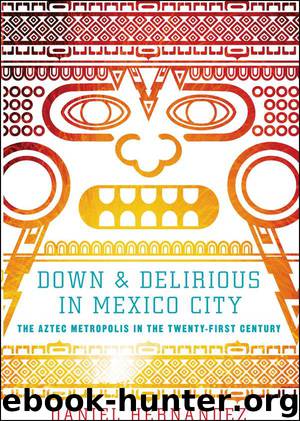Down and Delirious in Mexico City: The Aztec Metropolis in the Twenty-First Century by Daniel Hernandez

Author:Daniel Hernandez [Hernandez, Daniel]
Language: eng
Format: azw3
Publisher: Scribner
Published: 2011-02-08T05:00:00+00:00
10 | Negotiating Saints
Absorbing the beat at a sonidero in Tepito. (Photo by Livia Radwanski.)
It is an overcast Sunday afternoon in the bleak D.F. suburb of Tultitlán, where a few dozen people are gathered for the one-month anniversary rosary for Jonathan Legaria Vargas, the man they called El Padrino and El Pantera—or the Panther—now deceased. In the yard of Legaria’s unofficial outdoor church on a desolate industrial avenue next to a used-car lot, families with grandmothers and infants stand alongside tables offering tamales, fresh juices, and beef stew. With flowers, a mariachi band, and the recitation of the rosary, the ceremony has all the trappings of a traditional Mexican Catholic mourning ritual. Two elements, however, stand out: the altar before them, enclosed with a miniature skeleton dressed in a gleaming white robe and a tiara, bony jaw agape, eyes hollow; and an enormous seventy-two-foot-tall statue made of plywood and fiberglass that Legaria had erected to his chosen spiritual mother, the Santa Muerte. Death is in a black robe, her face shrouded by a hood, her skeletal arms outstretched, like something out of a theme-park ride, crazed and nightmarish. Glancing up at it every few seconds, I half expect the structure’s robe to mechanically split open and reveal the entrance to a hall of mirrors.
“O Most Divine and Most Precious Holy Death,” the mourners chant in unison, kneeling before the Santa Muerte altar. “Cure the jealous . . . guard the moribund . . . bless El Padrino . . .”
The prayer is led by Legaria’s widow, Constantine, a young woman with pale, freckled skin and furiously curly, lemon-colored hair. She wears jeans and a small, stylish jacket and holds a microphone. “O Most Holy Death . . . ,” she chants, curving the tone of her words from down to up, as if conducting a hypnosis. And the people repeat each line.
“In silence I remain here . . .” “In silence I remain here . . .”
“Waiting for the moment . . .” “Waiting for the moment . . .”
“That will take me to you . . .” “That will take me to you . . .”
After a while, I am mouthing the chants myself, letting them roll through my brain. I am treated cordially and warmly by the attending women, Constantine’s assistants. I have tamales, and when the prayers are over, after the mariachi sing “Amor Eterno,” the traditional ballad of farewell, each person places a white carnation before another large Santa Muerte figure dressed in a crimson gown, crossing himself or herself. Constantine then leads a procession of her dead husband’s followers along the avenue out front. They carry flowers and candles and banners and march behind a limousine that El Pantera had custom-painted with images of the Santa Muerte and the call letters of his Santa Muerte radio show. Throughout the afternoon, the mariachis play, the food and drink flow, and the children run happily around the huge Death statue and a small field of humanlike skulls spread out on patches of grass, in grids.
Download
This site does not store any files on its server. We only index and link to content provided by other sites. Please contact the content providers to delete copyright contents if any and email us, we'll remove relevant links or contents immediately.
| Anthropology | Archaeology |
| Philosophy | Politics & Government |
| Social Sciences | Sociology |
| Women's Studies |
Nudge - Improving Decisions about Health, Wealth, and Happiness by Thaler Sunstein(6636)
iGen by Jean M. Twenge(4702)
The Fire Next Time by James Baldwin(4346)
Adulting by Kelly Williams Brown(3674)
The Sports Rules Book by Human Kinetics(3590)
The Hacking of the American Mind by Robert H. Lustig(3581)
The Ethical Slut by Janet W. Hardy(3505)
Captivate by Vanessa Van Edwards(3302)
Mummy Knew by Lisa James(3170)
In a Sunburned Country by Bill Bryson(2948)
Ants Among Elephants by Sujatha Gidla(2926)
The Worm at the Core by Sheldon Solomon(2921)
Suicide: A Study in Sociology by Emile Durkheim(2611)
The Slow Fix: Solve Problems, Work Smarter, and Live Better In a World Addicted to Speed by Carl Honore(2575)
Humans of New York by Brandon Stanton(2381)
Handbook of Forensic Sociology and Psychology by Stephen J. Morewitz & Mark L. Goldstein(2379)
Blackwell Companion to Sociology, The by Judith R. Blau(2320)
The Happy Hooker by Xaviera Hollander(2274)
Outliers by Malcolm Gladwell(2259)
